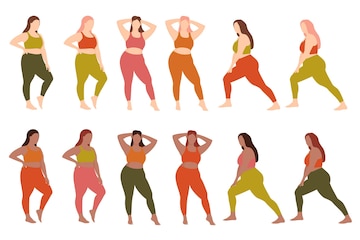Body Fat and You-How They Affect Your Health and Fitness
Are you frustrated with those stubborn pockets of fats that just won’t go away, no matter how much you exercise or watch your diet? Understanding the different types of body fats is the first step to tackling this common problem. In this article, we will delve into the various types of body fats and how they can impact your health and fitness goals.

What is total body fat?
Well, it is the amount of fat in the body which makes you look beautiful, ugly, ideal, overweight or obese. Fats give shape and contour to our body.
Any amount of fat in excess of the ideal body weight is liable to cause morbidity i.e. illnesses like hypertension, diabetes, osteoarthritis etc.
Types of Body Fats
There are two main types of body fats: subcutaneous, visceral and brown fats.

Subcutaneous fat is located just beneath the skin and is the type of fat that is typically associated with body shape and size.
Visceral fat, on the other hand, is located deep within the abdominal cavity and surrounds vital organs such as the liver, pancreas, and intestines.
Brown fat, also known as brown adipose tissue (BAT), is a type of fat found in our bodies that is responsible for generating heat.
While both types of fat can contribute to health issues when present in excess, visceral fat is particularly concerning because it has been linked to an increased risk of chronic diseases such as type 2 diabetes, heart disease, and certain types of cancer.
It is important to maintain a healthy body fat percentage through a balanced diet and regular exercise to reduce the risk of these health issues.
Subcutaneous Fat

Subcutaneous fat is the most visible type of fat as it lies just beneath the skin. It is the fat you can pinch and can vary in thickness and distribution throughout the body. While subcutaneous fat can be unsightly and contribute to the appearance of cellulite, it generally poses a lower risk to your overall health compared to other types of fat.
One of the main roles of subcutaneous fat is to provide insulation and cushioning for the body. It helps regulate body temperature and protects vital organs from external forces. However, excess subcutaneous fat, especially around the abdominal area, can be an indicator of poor metabolic health and increase the risk of developing chronic conditions such as type 2 diabetes and heart disease.
Visceral Fat
Visceral fat, also known as abdominal or intra-abdominal fat, is the fat that surrounds your organs, such as the liver, pancreas, and intestines. Unlike subcutaneous fat, visceral fat is not visible from the outside and can only be assessed through medical imaging techniques or waist circumference measurements.
While everyone has some level of visceral fat, excessive accumulation of this type of fat is strongly associated with metabolic disorders and increased risk of developing chronic diseases.
Visceral fat is metabolically active and releases hormones and other substances that can disrupt the body’s normal functioning. It has been linked to insulin resistance, inflammation, and dyslipidemia, all of which contribute to the development of type 2 diabetes, cardiovascular disease, and certain types of cancer.
Brown Fat
Unlike subcutaneous and visceral fat, brown fat is a special type of fat that plays a beneficial role in metabolism and weight management.
It is primarily found in newborns and hibernating mammals, but recent research has shown that adults also possess small amounts of brown fat, mainly in the neck and upper back area.
Brown fat is responsible for generating heat by burning calories, a process known as thermogenesis. It contains a higher number of mitochondria, which are the energy-producing powerhouses of cells, compared to other types of fat.
Increasing the activity of brown fat has been suggested as a potential strategy for weight loss and improving metabolic health.
Unlike white fat, which stores excess calories, brown fat burns calories to produce heat. This makes it an important asset for maintaining a healthy weight and keeping our bodies warm in cold temperatures. Recent studies have shown that activating brown fat can also have other health benefits, such as improving insulin sensitivity and reducing the risk of obesity and diabetes.
One way to activate brown fat is through regular exercise, which has been shown to increase brown fat activity. Another way is by exposing oneself to cold temperatures, such as taking cold showers or spending time in a cold room.
While brown fat is mostly found in babies and young children, adults also have small amounts of it in their bodies. Researchers are currently investigating ways to increase brown fat in adults as a potential treatment for obesity and metabolic diseases.
Body Fat Distribution Differences Between Men and Women
Body fat distribution varies between men and women due to hormonal differences and genetic factors. Women tend to have a higher percentage of essential fat, which is necessary for reproductive and hormonal function.
This essential fat is typically stored in the breasts, hips, and thighs. On the other hand, men tend to accumulate more fat around the abdomen, which is associated with a higher risk of metabolic disorders.
The differences in body fat distribution have implications for health and fitness goals. Women may find it more challenging to lose fat in certain areas, such as the hips and thighs, while men may need to pay extra attention to reducing abdominal fat for optimal health.
Health Risks Associated With Excess Body Fat
Excess body fat, regardless of type, is associated with a range of health risks. Obesity, defined as having a body mass index (BMI) of 30 or higher, increases the likelihood of developing chronic conditions such as diabetes, heart disease, stroke, certain cancers, and musculoskeletal disorders.
Subcutaneous fat, while generally less harmful than visceral fat, can still contribute to insulin resistance and metabolic abnormalities when present in excessive amounts.
Visceral fat, with its metabolically active nature, is particularly detrimental to health and is strongly associated with insulin resistance, high blood pressure, dyslipidemia, and systemic inflammation.
Furthermore, excess body fat can have a negative impact on psychological well-being and self-esteem. It may contribute to body image dissatisfaction and increase the risk of developing eating disorders or disordered eating patterns.
Conclusion
Understanding the different types of body fats and their impact on health and fitness is crucial for achieving your weight loss and overall health goals.
While subcutaneous fat may be less harmful than visceral fat, excess body fat of any kind can increase the risk of chronic diseases and negatively affect psychological well-being.
Final words
I am sure you have now understood the different types of body fats. In my next article, Part 2 of this series we will learn how to measure body fats and the different methods available to do it.
Do share this article with your friends using the social media icons at the bottom of this article. You can also share by Clicking to Tweet here-
BODY FAT MEASUREMENT-PART 1 Share on XAdios

